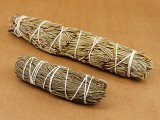Leaves, Bundle, Small from Sweden (SKU 4699)
Mugwort is a common name for several species of aromatic plants in the genus Artemisia. Mugwort is also known as “Dreamweed” for its unique ability to stimulate dreams. It is renowned as a smudging herb for its subtle, sweet scent and dream-inducing qualities. It has a long history of use in the Pagan tradition and is still used in modern-day Pagan magical practices as incense and for smudging or spell work. Each Mugwort smudge stick is unique and varies in size and shape. Detailed information can be found below.
Dimensions: 12 x 2,5 cm. Approximate weight 25 gr.
Mugwort is a common name for several species of aromatic plants in the genus Artemisia. In Europe, Mugwort most often refers to the species Artemisia vulgaris, or common Mugwort. Mugwort is also known as “Dreamweed” for its unique ability to stimulate dreams. It is renowned as a smudging herb for its subtle, sweet scent and dream-inducing qualities. It has a long history of use in the Pagan tradition and is still used in modern-day Pagan magical practices as incense and for smudging or spell work.
In some magical traditions, Mugwort is associated with divination and dreaming. To bring about prophecy and divinatory success, make an incense of Mugwort to burn at your workspace, or use it in smudge sticks around the area in which you are performing divination rituals. Mugwort was also used in Anglo-Saxon Britain to cure people who had fallen victim to “elf-shot,” which appears to be a catch-all term used to apply to people who had become sick at the hands of evil spiritual entities. Sailors often smoked mugwort instead of Cannabis or Tabaco, and the plant came to be known as “Sailor’s Tabaco.” North American First Nation tribes used Mugwort leaves to rub on one’s body as protection from ghosts. They also wore necklaces made of the leaves to avoid dreams about dead people.
Artemisia, Ἀρτεμισία, referring to the Greek goddess Artemis who so benefited from a plant of this family that she gave it her own name. Plants described by Dioscorides and Pliny like Wormword or Mugwort from which the genus name Artemisia is taken. An alternative possibility for the derivation of this name is that it comes from Queen Artemisia II of Caria, sister and wife of King Mausolus, who ruled after his death from 352 to 350 BCE. and built during her short reign one of the Seven Wonders of the Ancient World, the Mausoleum at Halicarnassus, which she unfortunately did not live to see the completion of.
Artemisia vulgaris is used from way back to let recover tired travellers and to protect them against evil spirits and wild animals. Roman soldiers laid it in their sandals against painful feet, hence the name "bij-voet" in Dutch. William Coles (1626 - 1662 CE), an herbalist, botanist, became entranced by the idea of plant signatures. In the Art of Simpling, 1656, he wrote: "And if a Footman take Mugwort and put it into his shoes in the morning, he may go forty miles before noon and not be weary…" Dr. Karl Wilhelm Burdach (1781 - 1842) of Triebel, discovered that the root of the Artemisia vulgaris is an excellent remedy in epilepsy. Artemisia is used as food plant by the caterpillars of a number of Lepidoptera (butterflies and moths).
Each Mugwort smudge stick is unique and varies in size and shape.
Other names: Bijvoet, Artemisia vulgaris,
This item is not allowed in the following countries:
Taiwan
This is a natural product, used as incense or in perfumery, or as an ingredient of incense and other perfumery or potpourri preparations.
Some incense plants or products may have some history of other folklore purposes, but we offer this product for its use as incense. Not food grade, not for consumption.
Please read our Terms & Conditions before placing your order.


























